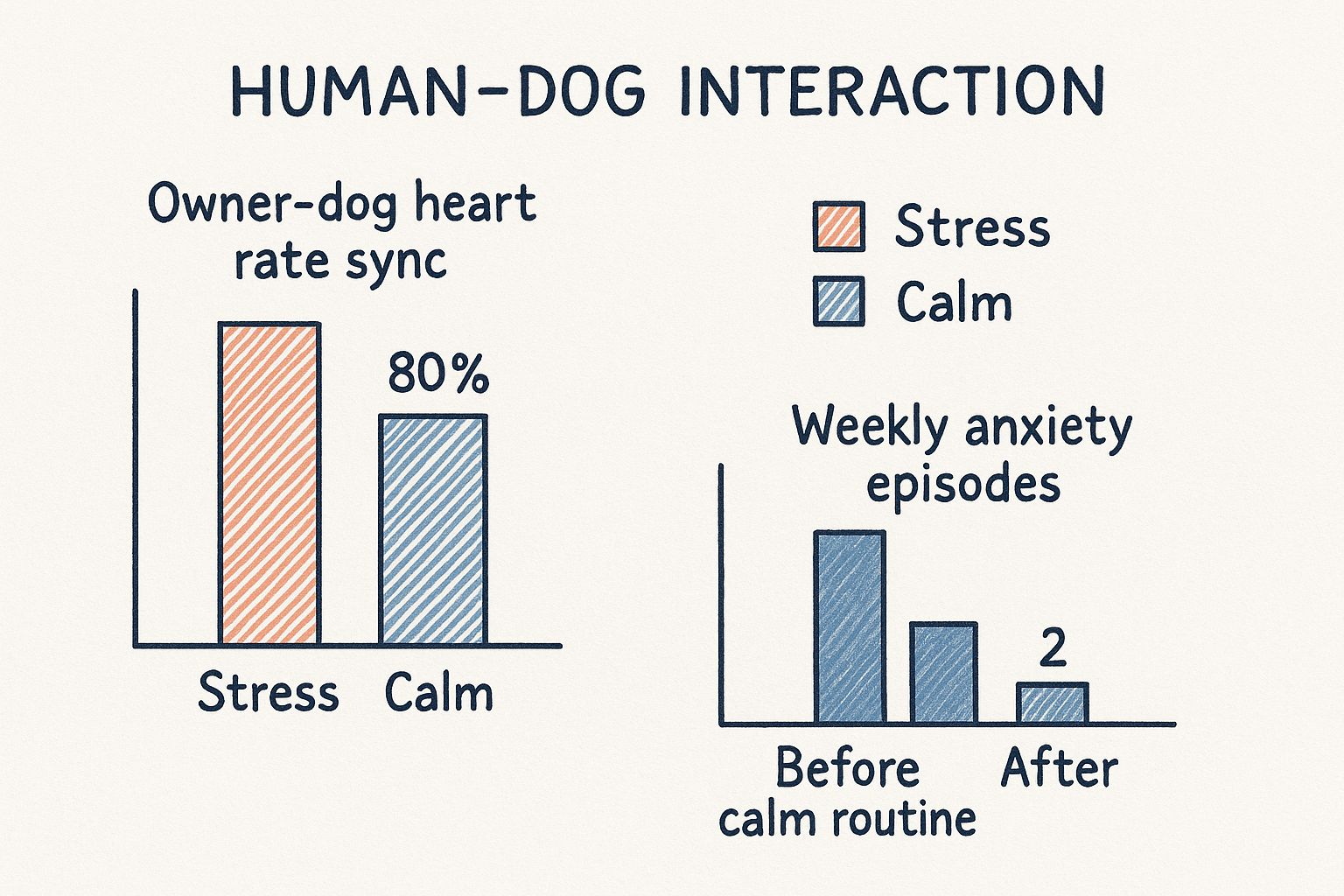When it comes to soothing an anxious dog, natural remedies offer a gentle yet powerful alternative. From calming supplements and pheromones to simple tweaks in their routine and environment, these approaches work with your dog’s biology, not against it. Many UK owners are discovering that a thoughtful blend of these strategies can make a world of difference, easing stress without immediately turning to prescription medication.
Understanding Your Dog's Anxiety

It’s painful to watch your best friend in distress. Seeing them tremble during a thunderstorm or finding they’ve chewed the furniture while you were out isn't just frustrating; it's a clear sign they’re struggling. Think of canine anxiety as a smoke alarm that's just a bit too sensitive. It’s a perfectly normal survival instinct, but it’s been dialled up too high, causing a full-blown panic response to things that aren't real threats.
And if you’re dealing with this, you are far from alone. Research shows that a staggering 72.5% of dogs display at least one anxiety-related behaviour. This isn't just a small-scale issue; it's a widespread challenge facing dog owners everywhere, highlighted in detailed studies like the one featured on My Anxious Dog's blog.
Common Triggers for Canine Anxiety
The first step to helping your dog is to figure out what’s setting off their internal alarm. Anxious reactions don't just happen out of the blue; they’re almost always linked to specific fears or past experiences.
Some of the most common culprits include:
- Separation: Many dogs, especially those bred for companionship, form incredibly strong bonds and can't cope when left by themselves.
- Loud Noises: The sudden boom of fireworks, the rumble of a thunderstorm, or even the whir of the vacuum cleaner can be terrifying.
- New Environments: A visit to the vet, the chaos of a car journey, or meeting a house full of strangers can easily overwhelm a sensitive dog.
- Past Trauma: For rescue dogs, in particular, negative experiences from their past can leave lasting emotional scars that trigger fear.
By getting to the root of why your dog is scared, you can start making much smarter choices about how to help them feel safe again. This is the foundation for choosing natural remedies that will actually work for your dog's specific needs.
To help you get started, we've put together a quick overview of the natural solutions we'll be exploring in this guide.
Quick Guide to Natural Anxiety Solutions
| Remedy Type | Primary Goal | Examples |
|---|---|---|
| Herbal Supplements | To promote calm by supporting the nervous system. | L-tryptophan, Valerian Root, Passionflower |
| Dietary Changes | To improve gut health and neurological function. | Probiotics, Omega-3s, magnesium-rich foods |
| Behavioural Strategies | To build confidence and change emotional responses. | Desensitisation, counter-conditioning, training |
| Environmental Tweaks | To create a safe, predictable, and calming space. | Pheromone diffusers, calming beds, white noise |
This table is just a snapshot, but it gives you an idea of the different angles from which you can approach your dog's anxiety.
Before we dive into the solutions, it’s crucial to know exactly what you’re looking for. Recognising the subtle cues is key. Our guide on the common signs of anxiety in dogs can help you become fluent in your dog's body language, empowering you to respond with the right support at the right time.
How Your Calmness Can Soothe Your Dog
Have you ever had one of those days, where everything feels frantic and stressful, only to notice your dog is suddenly pacing and on edge? It’s no coincidence. Our dogs are masters at reading our emotional state, and our own anxiety can easily spill over onto them.
This phenomenon is known as emotional contagion. Think of it like a pair of tuning forks. When you're vibrating with stress, your dog—the other tuning fork—often starts to resonate at that same anxious frequency. It’s not just in their heads; it's a genuine physiological response.
The Science Behind the Connection
Your presence is one of the most powerful tools you have for soothing your dog, but it's a double-edged sword. When you're tense, your body language changes, your breathing gets shallow, and your heart rate climbs. Your dog picks up on all these subtle signals and naturally concludes there must be a threat nearby. Their own anxiety starts to rise in response.
This isn’t just anecdotal. Groundbreaking research from Queen’s University Belfast has shown that dogs are physiologically tuned in to their owners' stress. The study found that fluctuations in an owner's heart rate could accurately predict similar changes in their dog's, offering concrete proof that our stress directly affects our pets. If you're curious, you can discover more about how your stress affects your dog and dive into the data yourself.
This infographic brilliantly shows just how deep that connection runs and the incredible difference a calm owner can make.

The data speaks for itself. When we remain calm, that intense physiological link weakens, and our dogs experience far fewer anxious episodes.
Becoming Your Dog's Anchor in the Storm
Realising this connection is one thing; using it to help your dog is the next step. You can actively become a source of stability and safety for them. This doesn't mean you have to be a Zen master 24/7—life is stressful! It’s about learning to manage how you project that stress when your dog is around.
Your calm, predictable behaviour sends a powerful message to your dog: "I've got this, and you are safe." This feeling of security can often be more effective than any single supplement or remedy.
Here are a few simple ways to manage your own stress and help your dog feel more secure:
- Practise Mindful Breathing: When you feel yourself getting tense, take a moment for a few deep, slow breaths. This simple act lowers your heart rate and sends a clear "all clear" signal to your dog.
- Create Calm Routines: Dogs find comfort in predictability. Sticking to consistent times for walks, meals, and even quiet cuddle time builds a stable rhythm that minimises uncertainty for both of you.
- Use a Soothing Tone: When things get stressful—like during a thunderstorm or fireworks—make a point to speak to your dog in a low, gentle voice. Your steady tone is a powerful form of reassurance.
By consciously managing your own emotional state, you become the calm centre of your dog's world. This isn't just a nice idea; it's a fundamental part of a truly holistic approach to managing their anxiety.
Choosing Natural Calming Supplements and Pheromones

Sometimes, even the best training plans and a peaceful home environment need a helping hand. This is where natural calming supplements and pheromones can make a real difference, offering a gentle boost to your dog’s emotional well-being without resorting to strong medication.
Think of them not as a magic wand, but as a way to turn down the background noise in your dog's anxious mind. By lowering that mental "static," they can become much more receptive to training and less likely to tip over into a state of panic. These remedies work by supporting the body’s own calming pathways, giving it the resources it needs to find a more balanced state.
A Closer Look at Herbal Supplements
People have turned to herbs for relaxation for centuries, and many of these same botanicals have been carefully formulated for our canine friends. These supplements use plant-based ingredients to provide gentle, natural support for a stressed nervous system.
You’ll often see a few key ingredients in these calming blends:
- Chamomile: It’s not just for our bedtime tea! Chamomile contains compounds that have a mild soothing effect on dogs, making it a great choice for general, low-level anxiety.
- Valerian Root: This one packs a bit more of a punch. Valerian is known for its more noticeable sedative qualities and can be brilliant for dogs who just can't seem to switch off or who struggle to sleep because of stress.
- L-theanine: Found in green tea, this clever amino acid helps the brain produce more calming neurotransmitters. The big advantage? It promotes a sense of relaxation without making your dog drowsy.
It’s absolutely crucial to use products made specifically for dogs. Human supplements can have different potencies or contain additives like xylitol, which are toxic to dogs. For targeted issues, such as the distress of being left alone, specially formulated separation anxiety dog treats can offer focused, natural support.
The Science of Scent: Pheromones
Pheromones offer a completely different but powerful way to send calming signals to your dog. Dog-Appeasing Pheromones (DAP) are a synthetic copy of the scent a mother dog releases to comfort her puppies. It’s an invisible, odourless message that essentially tells your dog’s brain, "You're safe here. Relax."
Pheromone diffusers, which you plug into the wall, or calming collars work quietly in the background. They create a constant bubble of reassurance, which is incredibly helpful for managing anxiety triggered by a new home, scary fireworks, or separation.
Because they are not a drug and only dogs can detect them, they are exceptionally safe and have no effect on people or other pets in your home.
Comparing Popular Natural Calming Aids
With so many options, choosing the right one can feel a bit daunting. This table breaks down the most common remedies to help you decide what might suit your dog's specific situation.
| Remedy | Best For | How It Works | Consult a Vet? |
|---|---|---|---|
| Chamomile | Mild, generalised anxiety and restlessness. | Contains natural compounds that act as a gentle sedative. | Yes. Good to check dosage and rule out allergies. |
| Valerian Root | Moderate to severe stress, sleep issues, travel anxiety. | Acts on brain receptors to promote deeper relaxation. | Absolutely. It’s potent and can interact with medications. |
| L-theanine | Stress without sedation (e.g., for training focus). | Increases calming neurotransmitters like dopamine and serotonin. | Yes. Important to ensure correct dosage for your dog's size. |
| DAP Pheromones | Environmental anxiety, settling into new spaces, separation issues. | Mimics a mother dog’s comforting scent, signaling safety. | No. Generally considered very safe, but worth mentioning to your vet. |
No matter which path you choose, the goal is to find what helps your dog feel most secure.
Making a Smart and Safe Choice
Navigating the world of natural aids is all about matching the product to your dog's unique personality and triggers. The most important step? Always have a chat with your vet.
They can help you confirm that anxiety is the root cause (and not a hidden medical issue) and make sure a new supplement won’t interfere with any existing medications. When you do start something new, begin with the lowest recommended dose and watch how your dog responds. A little patience goes a long way.
Using Behavioural Training and Mental Enrichment
Anxious energy has to go somewhere, and a bored, understimulated mind often defaults to worry. While supplements can help take the edge off, behavioural training and mental enrichment are the real game-changers. They get to the root of the problem by giving your dog a sense of purpose and control—two of the most powerful antidotes to fear.
Think of it like giving a restless employee a meaningful project. When your dog has a job to do, whether it's figuring out a puzzle toy or listening for a cue, they have far less mental bandwidth for spiralling into anxiety. This whole approach builds confidence from the inside out, teaching them that they're capable of handling challenges and navigating the world.
Building Confidence Through Predictability and Training
Dogs are creatures of habit, and they find huge comfort in knowing what’s coming next. A predictable daily routine—for meals, walks, and playtime—creates a stable framework that reduces the kind of uncertainty that fuels anxiety.
Once you have that routine, positive reinforcement training becomes your most valuable tool for building a resilient, confident dog. It’s all about rewarding the good stuff instead of punishing the bad. When your dog nails a command and gets a tasty treat or some enthusiastic praise, it creates a powerful positive feedback loop in their brain. Over time, this builds their self-esteem and deepens your bond, positioning you as their ultimate source of safety.
At its core, positive training is about clear communication and trust. It teaches your dog that good things happen when they listen to you, turning potentially scary situations into opportunities for reward.
Redirecting Anxious Energy with Brain Games
A bored brain is a playground for an anxious mind. Mental enrichment, or what I like to call 'brain games', is a brilliant way to channel all that nervous energy into something focused and rewarding. A mentally tired dog is a happy, calm dog.
Here are a few simple ideas to get you started:
- Puzzle Toys: Toys that dispense food make your dog think, sniff, and problem-solve to get their dinner. This taps into their natural foraging instincts and gives them a fantastic mental workout.
- Scent Work: You don’t need any fancy kit for this. Just hide a few high-value treats around a room and encourage your dog to "find them." Engaging their incredible sense of smell is one of the best ways to tire them out.
- Learning New Tricks: Teaching a new cue, no matter how simple, demands concentration. A quick, fun five-minute training session can do wonders to refocus a worried mind.
Gently Facing Fears with Desensitisation
For dogs with specific phobias, like fireworks or traffic noise, a technique called desensitisation and counter-conditioning can be life-changing. It’s a slow, methodical process of exposing your dog to a very low level of their trigger—so quiet they notice it but don't react—while pairing it with something they absolutely love, like bits of chicken.
Slowly, over many sessions, you gradually increase the intensity of the trigger. This gently rewires their brain to associate the scary thing with the amazing treat. Their emotional response shifts from "that sound is terrifying!" to "that sound means I get chicken!" It demands patience, but it's one of the most effective ways to conquer deep-seated fears.
The power of these behavioural approaches is being recognised more and more across the UK. In fact, specially trained dogs are now used in thousands of health and educational settings to provide emotional support. It’s a testament to the profound impact of positive, structured interaction. If you’re interested, you can find out more about dog-assisted interventions in the UK and see how these incredible programmes work.
Creating a Calm and Secure Home Environment
 Your home should be your dog's ultimate safe space. For a dog struggling with anxiety, their environment isn't just a physical place; it directly shapes their emotional well-being. By making a few thoughtful adjustments, you can transform your home from just a house into a genuine sanctuary that helps to calm their nerves.
Your home should be your dog's ultimate safe space. For a dog struggling with anxiety, their environment isn't just a physical place; it directly shapes their emotional well-being. By making a few thoughtful adjustments, you can transform your home from just a house into a genuine sanctuary that helps to calm their nerves.
This isn't about expensive renovations. It's about learning to see your home through your dog's eyes and ears, then making small but powerful changes. These tweaks introduce a sense of security and predictability—two of the most fundamental remedies for canine anxiety.
Crafting the Perfect Safe Haven
Every dog, no matter their personality, needs a "den." This is their private, comfortable spot where they can retreat when the world feels overwhelming. It’s crucial that this space is never used for punishment, but is instead a personal haven that’s always available and respected by everyone in the family.
Think of it as their own little bedroom. It could be an open-door crate draped with a blanket to feel more enclosed, a cosy nook under a desk, or simply a plush bed in a quiet corner. The only rule is that this space is theirs and theirs alone.
A dedicated safe space gives your dog a sense of control. When they feel overwhelmed, they have a reliable place to go to self-soothe, which is a vital skill for managing anxiety.
To make their den truly inviting, you might want to consider a bed designed for comfort. A high-quality calming dog bed with raised rims can create a sense of being securely nestled, almost like a puppy cuddled up to its mother. This provides a level of security that a simple flat mat often can't match.
Managing Sensory Input
Anxious dogs are often hyper-aware of sights and sounds. The unexpected slam of a car door or the rumble of a passing lorry can be enough to send their stress levels soaring. You can help by taking control of the sensory environment in your home.
Here are a few simple but incredibly effective ideas:
- Mask Startling Noises: Leaving on some calming classical music or using a white noise machine creates a steady, soothing audio background. This can help drown out sudden, jarring sounds from outside, making them far less likely to startle your dog.
- Control Visual Triggers: Does your dog bark frantically at every person or animal that walks past the window? A translucent window film is a brilliant solution. It lets in all the natural light but blurs the view, removing a constant source of stress and reactivity.
The Role of Exercise and Nutrition
Finally, never underestimate how physical well-being impacts mental health. A dog brimming with unspent energy is a dog primed for anxiety. Making sure they get plenty of appropriate daily exercise is key to burning off that nervous energy and releasing mood-boosting endorphins.
Diet plays a surprisingly significant part, too. A well-balanced diet that includes nutrients like omega-3 fatty acids and magnesium can support healthy brain function and promote a more stable mood. Just as with us, what a dog eats directly affects how they feel, making nutrition a core part of any holistic plan to manage anxiety.
Knowing When to Seek Professional Help
Natural remedies can be a fantastic way to manage your dog's anxiety and really improve their day-to-day life. But it's important to see them as one tool in a bigger wellness kit, not always the complete fix. Knowing the limits of what you can do at home and when it’s time to call in a professional is one of the most responsible things you can do as a dog owner.
Think of it this way: you might handle a mild headache with rest and water, but for a blinding migraine that won't quit, you’d see a doctor. It’s the exact same principle for your dog’s mental wellbeing. Some situations just need the eye of a trained expert.
Reaching out for professional help isn’t a sign you’ve failed. Far from it. It’s a sign that you are absolutely dedicated to getting the best possible care for your furry friend.
Red Flags That Mean It's Time for an Expert
You know your dog better than anyone, but some behaviours are clear signals that something more serious is going on. If you spot any of the following, it’s a good idea to book an appointment with your vet or a certified animal behaviourist.
- Aggression: Any kind of aggression—growling, snapping, or biting—needs immediate professional attention, whether it's aimed at people or other animals.
- Severe Destructive Behaviour: A bit of chewing is one thing. But if your dog is causing serious damage to your home whenever they're alone, it could be a sign of extreme panic.
- Self-Harm: Behaviours like obsessive licking, chewing on paws, or frantic tail-chasing that lead to sores or injuries are a major red flag.
- Unmanageable Distress: Your dog is in a state of severe panic (think uncontrollable trembling, howling, or toileting indoors) and nothing you do seems to calm them down.
Your vet should always be your first port of call. They can rule out any underlying medical issues that could be causing the anxiety and can refer you to a qualified behaviourist who can create a plan specifically for your dog.
At the end of the day, combining your daily love and support with expert guidance is what gives your dog the best shot at living a calm, confident, and happy life.
Got Questions? We've Got Answers
When you start exploring natural ways to ease your dog's anxiety, it's normal for a few questions to pop up. Getting to grips with the details is the best way to build a plan that's both safe and effective for your four-legged friend. Let’s clear up a couple of the most common queries we hear from dog owners.
How Long Does It Take for Natural Remedies to Work?
This is the big question, and the honest answer is: it depends. Every dog is an individual, with their own metabolism, history, and level of anxiety, so there’s no single timeline.
-
Quick Comfort: Some aids, like pheromone diffusers or specific calming chews, can start to take the edge off within a few hours or days. Think of these as your go-to for predictable, short-term worries, like an upcoming car ride.
-
Gradual Support: Herbal supplements, such as valerian root, need a bit more time. You'll often need to give them consistently for a few weeks for their full calming effects to build up in your dog’s system.
-
Lifestyle Shifts: Behavioural work, like desensitisation training, is a marathon, not a sprint. You're helping your dog build new, positive connections and confidence, which is a gradual process. Progress here is measured in weeks and months, and consistency is everything.
The best strategy is a mix of patience and observation. Try keeping a simple diary to note your dog's behaviour. Tracking those small wins helps you see the bigger picture and understand what’s truly making a difference over time.
Can I Combine Different Natural Remedies?
Yes, and in most cases, you absolutely should! A multi-faceted approach is almost always more effective. You're tackling the anxiety from different angles when you pair a calming supplement with a predictable daily routine and throw in a few puzzle toys for mental enrichment.
But—and this is a big but—you need to be smart about it, especially when it comes to supplements. Never mix multiple herbal remedies without chatting with your vet first. They’re the only ones who can give you the green light on safe combinations and dosages, making sure you avoid any risky interactions or over-sedation. Your goal is a calm, happy dog, and that starts with safety.
At Tipaw, we're dedicated to helping your dog feel their best with natural, vet-approved solutions. To see our range of calming supplements designed to bring a little more peace to your home, just visit us at https://www.store-tipaw.com.





